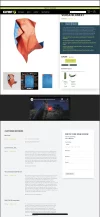Rather than sleeping bags, I always recommend looking at either backpacking sleeping quilts or a regular throw quilt which will both saving weight and pack small. This is I posted yesterday in response to that discussion.
-------------------------------------------------------------------
A backpacking sleeping quilt will reduce weight and still provide warmth. If you select one that is rated for 4.5 degrees C / 40 F, it can weigh under 480 gr 16 ounces.
An example:
https://www.amazon.com/dp/B0765968XC/?tag=casaivar02-20
-------------------------------------------------------------------
The idea of the quilt is that the insulation at the bottom of a sleeping bag is crushed by body weight and does not provide any insulation. Eliminating the weight by eliminating the bottom save considerable weight. The quilt that I provided a link for is a very basic configuration for a quilt, but cheap.
The backpacking quilt I use is designed with various fasteners and connectors that can be use to configure the quilt in a number of ways. Mine also has a drawstring and snaps at the bottom which can be used to form a 'box' for the feet. When backpacking, it is used with a pad or ultra light air mattress. My frequent favorite use is to have it fully open except for the bottom, and just snug it around me like a blanket.
I have several quilts, each is designed for a specific temperature range. The one I use on Camino and during backpacking in the summer months at altitude in the mountains is conservatively rated for temps down to 45f/7c. In practice, though, because I wear base layers to sleep in on the trail or Camino, that specific quilt keeps me plenty warm down to the upper 30's f / 3 c. It weighs about 13 ounces / 368 grams.
Since I wear lightweight base layer tops and bottoms while sleeping, the air mattress provides the bottom insulation while I am backpacking. On Camino, the mattress on the beds provide the insulation. If you want to put a cover on the mattress, then you can use a super light weight length of fabric, like a
10D ripstop nylon or even
Tyvek 1443R .
Below are a couple of YouTubes of how my Enlightened Equipment quilt is used . . . or any quilt for that matter

Keep in mind that the reason I provided the link to the Black Diamond quilt was that your primary use is for indoor supplementation of existing bedding. You did not mention wilderness backpacking use. Since I already had my backpacking sleeping quilts, I could just grab the one I needed for Camino.
As used on Camino, my backpacking quilt did nothing more than the Black Diamond quilt would have done. So, you can get the light weight, extreme compressibility to conserve space in your pack, and warmth you need for much less cost than the backpacking quilts I use.
However,
IF I am using a quilt for wilderness backpacking, then it is the backpacking quilts from Enlightened Equipment that I own, or any other specifically designed backpacking quilt, is what I will take, not the Black Diamond type of quilt. So if you plan on needing a quilt for backpacking, then you might want to look at a specifically designed backpacking quilt.























